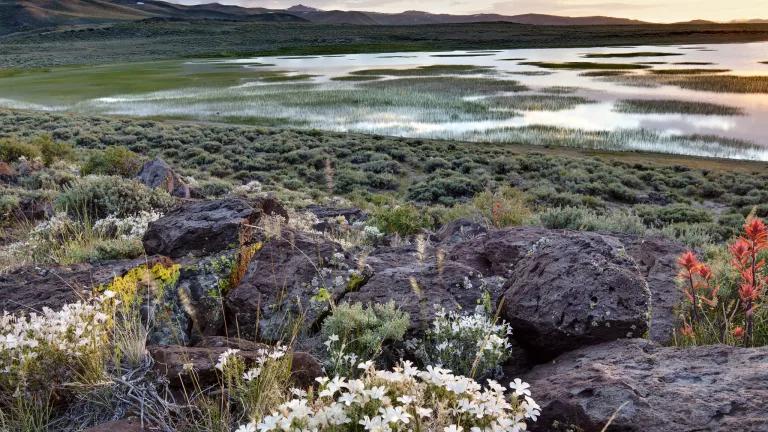PBS Frontline Updates Battle for Bristol Bay
Extended interview with Pebble CEO Tom Collier documents duplicity, financial conflict of interest, and why, when he speaks, “its sensible to be skeptical.”
Many people seem surprised to learn that the widely condemned Pebble Mine—proposed for construction at the headwaters of the world’s most productive wild salmon, in Alaska’s Bristol Bay—isn’t already dead. The Pebble Partnership has been abandoned by each of its major partners. The one partner remaining—a small under-funded Canadian exploration company called Northern Dynasty Minerals—is desperate for funds or a new partner and has been trying unsuccessfully to sell since 2011.
But the Pebble Mine isn’t dead—yet.
Virtually from the outset of its tenure in 2017, the Trump administration has made rescuing the Pebble Mine part of its deregulatory agenda, arguably the most environmentally destructive in modern history, regardless of political party:
- Never mind that EPA Administrators from the Nixon, Reagan, George H.W. Bush, and George W. Bush Presidencies—joined by Bruce Babbitt, former Interior Secretary under President Clinton—have condemned the Pebble Mine as “the wrong mine in absolutely the wrong place.”
- Never mind that the people of Bristol Bay remain actively, steadfastly opposed to the project by over 80 percent.
- And never mind that the few remaining backers of the project are the financially beleaguered shareholders of its Canadian owner.
Last week, PBS Frontline posted an extended update to its 2012 broadcast of “Alaska Gold,” which laid out the history of the Pebble controversy from the beginning. In this 2020 update—called “Alaska’s Controversial Pebble Mine Was Dead. Not Anymore”—the Pebble Partnership CEO Tom Collier is interviewed at length and, in the process, is given a rare opportunity to present the best possible case for the Pebble Mine in his own words.
And the result is an indictment not just of the mining scheme’s viability but of Collier’s trustworthiness as its principal spokesperson. Consider, for example, these excerpts on key issues in the Frontline update (emphases added):
Pebble’s attack on science in EPA’s Bristol Bay Watershed Assessment
Collier: “I think they were wrong there. I don’t think they did any good science.”
Fact: According to former EPA Region 10 Administrator Dennis McLerran, based on a publicly transparent three-year, twice-peer reviewed scientific review process, “ultimately we [EPA] concluded that placing restrictions on mining in that watershed was important to maintain the integrity of the fishery going forward.”
Pebble’s claim of bias in EPA’s Watershed Assessment process
Collier: The EPA Watershed Assessment “was a document that had a pre-determined outcome and was manipulated in order to get that result.”
Fact: Based on an investigation requested and ultimately attacked by Pebble itself, the EPA Inspector General concluded that “we found no evidence of bias in how EPA conducted the assessment.”
Pebble’s claims about the Army Corps of Engineers’ environmental review
Collier: “The U.S. Army Corps of Engineers—the least susceptible, I think, agency in America to political influence—has concluded in its draft [environmental impact statement] that this proposed mine project will have no impact on the fishery in Bristol Bay.”
Fact: In July 2019, the U.S. Department of the Interior formally commented that the Army Corps’ draft is “so inadequate that it precludes meaningful analysis.”
In July 2019, the U.S. EPA formally commented, based on the Corps’ draft EIS, that the proposed mine “may have substantial and unacceptable adverse impacts on fisheries resources in the project area watershed ….”
Pebble’s claims about the size of the mine
Collier: Regarding plans to expand the current “ten percent” mine plan, “there may be a phase 2, OK? …That’s somebody else’s decision. It’s not a decision that we’ve made. And it’ll be made at some point in the future.”
Northern Dynasty CEO Ron Thiessen: “We’re the largest undeveloped [copper and gold resource] in the world, so it is the kind of project that any mining company in the world would envy owning a piece of.”
Fact: According to Rick Halford, former President of the Alaska State Senate, “it’s totally illogical for a mining company to dig their way down to the high value material and then fill the hole back in and stop…. It is not a real proposal. They talk to the regulators about the small mine. They talk to the investors about the big mine. Which time are they telling the truth?”
Pebble’s claims about financial feasibility of the Pebble Mine
Collier: “We think we hit the sweet spot between economic viability and environmental protection. And that’s what we took into permitting…. I’m here to tell you that we wouldn’t be taking into permitting a project that wasn’t economically feasible.”
Fact: According to former Rio Tinto mining expert and environmental permitting director Richard Borden, “I would be shocked if it was economically feasible,” estimating based on his own analysis that the project would lose $3 billion. “There are few things more dangerous than a mine that loses money every year.” Urging Pebble to release an economic analysis, Borden asks “what better way to attract investors than showing they have a really favorable project on their hands?”
According to Anglo American, one of the former 50 percent owner of the project (before it walked away in 2013 from its $600 million investment), “upfront capital costs would be $11 billion - $13 billion—more than double the $4.7 billion Northern Dynasty-commissioned 2011 preliminary assessment.”
According to Kerrisdale Capital CEO Sahm Adrangi, on the abandonment of the Pebble project by former mining partners and mining company investors, “I think it indicates to us that when people are looking under the hood they’re finding a mining project that’s just not commercially viable.”
Pebble’s claims about the future of Bristol Bay
Collier: “I spent about a year talking to folks and reading what our opponents had published. I came forward with a smaller project that wouldn’t have the same impact in Bristol Bay.”
Fact: According to Daniel Cheyette of the Bristol Bay Native Corporation, “there are some places that really shouldn’t be mined, and a place that has the world’s most prolific sockeye salmon fishery is one of those places. The problem is that the people of Bristol Bay have to live with the consequences of this mine forever.”
Pebble CEO Collier’s conflict of interest
Fact: According to Frontline, in addition to his annual salary of “around $1.5 million,” Tom Collier has a $12.5 million bonus coming his way if he gets Pebble permitted this year. Does that sound like he has a personal conflict of interest, just the appearance of one, or no personal interest at all?
For more details—and to judge for yourself whether the people of Bristol Bay should trust Tom Collier with their future—you can read and watch the Frontline update here.
The people of Bristol Bay will never relent in their battle against the Pebble Mine.




